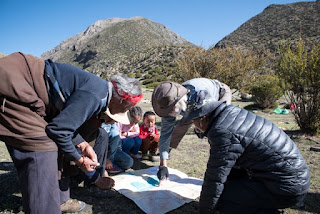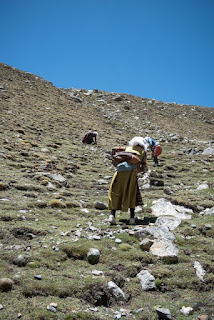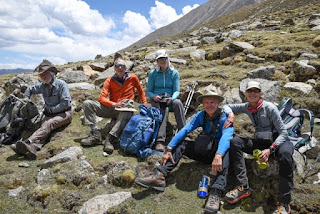 |
| Morning at Camp Two -- Look at that blue sky |
 |
| The yaks are here!! |
 |
| Gary reviews the map with the yak men (+curious local herders) |
We depart camp at 10:00 a.m., heading up now from 14,900' to 16,800' at Camp Three. Although we’re barely exceeding the elevation gain of one of our Atalaya training days, it’s a kick-ass hike at altitude. Straight out of camp we cross the river, which we will follow today. We cross on a bridge and keep our fingers crossed the yak do too.
I'm excited to be leaving behind roads and wires today (still faintly in view at Camp Two). Now we're headed up to a world without communication or motorized transportation. Around the world, but maybe particularly so in Tibet, I feel conflicted to see sloppy development erasing traditional ways of living (in this case an overt flexing of Chinese muscle -- invasion, domination and oppression). I suppose this is a romantic vision I hold. Progress is not bad. But the way it is happening in Tibet -- without choice or freedom -- is painful to me. So from my perhaps idealistic view, the world beyond the construction of roads, bridges, and commercial development is what to me feels like the real Tibet.
This is a long day for us. Full of highlights I note in my journal:
 Walking the valley, we spot high-flying Himalayan Griffon Vultures, and Lämmergeier on the ground so gorged on prey that
they hardly can lift their heavy bodies to fly -- instead hopping along like ostriches.
Walking the valley, we spot high-flying Himalayan Griffon Vultures, and Lämmergeier on the ground so gorged on prey that
they hardly can lift their heavy bodies to fly -- instead hopping along like ostriches.  |
| The Indiana Jones of Caterpillar Hunters |
 |
| Women scouring the slope for cordyceps |
 Criss-crossing the crystal clear river and streams humming through valley, we also pass herds of Himalayan goats, yak and sheep
tended by Tibetan families; and of course wildflowers too numerous to count.
Criss-crossing the crystal clear river and streams humming through valley, we also pass herds of Himalayan goats, yak and sheep
tended by Tibetan families; and of course wildflowers too numerous to count. |
| Happy at Lunch. R-L: Gary, Karl, Chris, Cliff and me |
By the time we rolled into camp some five hours after lunch, we were feeling the effects of a long and demanding trekking day. It was a stone sober meal shared by fellow hikers who previously had chatted through camp dinners of soup (every night for extra fluids), a carb-laden entree and dessert. We all were wiped. Even Cliff has a headache at the end of this day. Overnight snow fell, and we doubled our Diamox.
 |
| Camp Three, at last |



No comments:
Post a Comment